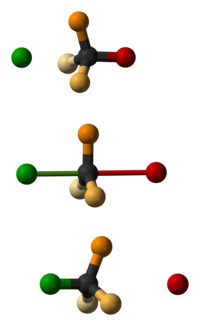
Photo from wikipedia
Contrary to the chiral inversion known in amines (R3N with R being an alkyl group), the stereoinversion in corresponding aminium salts (R3NH+, the protonated amine) is highly unlikely because of… Click to show full abstract
Contrary to the chiral inversion known in amines (R3N with R being an alkyl group), the stereoinversion in corresponding aminium salts (R3NH+, the protonated amine) is highly unlikely because of a high reaction barrier. A single water molecule facilitating chiral inversion in an aminium cation may thus be a rare phenomenon. This is revealed in present work, through quantum mechanical computations, while tracing the stereoinversion pathways in ethyl–methyl–vinyl amine (EMVA) and its aminium cation in gaseous state as well as in the presence of single water molecule acting as a catalyst, and also in a water-solvated environment. The pathways are explored through a global reaction route-mapping strategy employing high-level quantum-mechanical computations. Three multi-step routes for stereoinversion in aminium cation are traced, and the mechanistic details along with the thermodynamic and kinetic control in terms of Gibbs free energy have also been analyzed. Compared to the stereoinversion in molecules with carbon atom as stereocenter, the stereoinversion in EMVA with nitrogen as stereocenter is observed to be a multi-step process but with quite high reaction barrier. Though the gas-phase stereoinversion in the aminium cation is predicted to be infeasible, even along the proton transfer pathway which involves significant quantum tunneling, however, a single water molecule is observed to significantly lower the reaction barrier making aminium cation prone to chiral inversion.
Journal Title: Theoretical Chemistry Accounts
Year Published: 2017
Link to full text (if available)
Share on Social Media: Sign Up to like & get
recommendations!